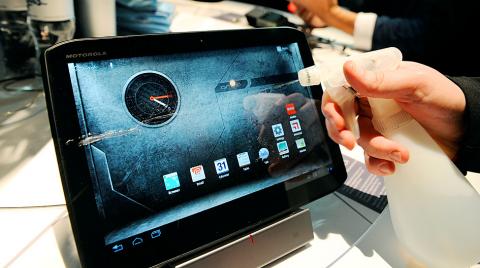Motorola Mobility and Lenovo (聯想) on Tuesday said they would use Intel processors in smartphones and other devices, giving the chipmaker its first entry into a market it has long coveted.
Intel Corp has struggled to bring down the power consumption of its chips so that they can be used in phones without draining the battery in a matter of hours. Meanwhile, phone-style chips from other manufacturers are starting to encroach on Intel’s PC chips, by becoming the chips of choice for tablet computers.
Lenovo Group Ltd will be first out the gate, with a smartphone called K800 for the Chinese carrier Unicom (中國聯通) in the second quarter, said Liu Jun (劉軍), a senior vice president at the company. The phone will have a 4.5 inch touch screen, will use Google Inc’s Android software for smartphones and tablets and will be able to stream video to TV sets equipped with Intel’s Wireless Display technology.

Photo: AFP
Motorola Mobility Holdings Inc CEO Sanjay Jha said he would have Intel-powered phones in testing this summer and ready for consumers a few months later. He did not provide any details about the Intel-powered devices, except to say that they would use Android. Motorola Mobility is set to be acquired by Google.
Intel said the phones would be able to run most applications straight from Google’s Android Market. Usually, switching to another processor family means applications will not run, but Intel said it has a way around that obstacle.
Microsoft Corp dealt Intel a blow last year by announcing that it would release its new operating system, Windows 8, in one version for Intel-style chips and another for phone-style chips that are based on designs from Britain’s ARM Holdings PLC.
Windows has run exclusively on Intel-type chips since the mid-1990s. Analysts expect ARM Windows to be used mainly for tablets when Windows 8 goes on sale late this year.
Separately, Nintendo Co’s upcoming Wii U game console will come with a controller that has a big, touch-enabled screen. At first glance, that seems like an obstacle to the kind of casual multiplayer gaming that made the first Wii console such a breakout hit.
However, in demonstrations on Tuesday, the company emphasized that the Wii U would work with the cheaper, stick-like Wii controllers as well, making family multiplayer games feasible.
Nintendo said the device would go on sale after the next Electronic Entertainment Expo gaming trade show in Los Angeles in June. The Wii U will be sold as a bundle with one touch-screen controller, which is almost as big as the game console itself. Nintendo has not said what the package or an extra controller would cost.
Touch screens are expensive, often accounting for nearly half of the cost of a phone or a tablet computer.

WEAKER ACTIVITY: The sharpest deterioration was seen in the electronics and optical components sector, with the production index falling 13.2 points to 44.5 Taiwan’s manufacturing sector last month contracted for a second consecutive month, with the purchasing managers’ index (PMI) slipping to 48, reflecting ongoing caution over trade uncertainties, the Chung-Hua Institution for Economic Research (CIER, 中華經濟研究院) said yesterday. The decline reflects growing caution among companies amid uncertainty surrounding US tariffs, semiconductor duties and automotive import levies, and it is also likely linked to fading front-loading activity, CIER president Lien Hsien-ming (連賢明) said. “Some clients have started shifting orders to Southeast Asian countries where tariff regimes are already clear,” Lien told a news conference. Firms across the supply chain are also lowering stock levels to mitigate

Six Taiwanese companies, including contract chipmaker Taiwan Semiconductor Manufacturing Co (TSMC, 台積電), made the 2025 Fortune Global 500 list of the world’s largest firms by revenue. In a report published by New York-based Fortune magazine on Tuesday, Hon Hai Precision Industry Co (鴻海精密), also known as Foxconn Technology Group (富士康科技集團), ranked highest among Taiwanese firms, placing 28th with revenue of US$213.69 billion. Up 60 spots from last year, TSMC rose to No. 126 with US$90.16 billion in revenue, followed by Quanta Computer Inc (廣達) at 348th, Pegatron Corp (和碩) at 461st, CPC Corp, Taiwan (台灣中油) at 494th and Wistron Corp (緯創) at

NEW PRODUCTS: MediaTek plans to roll out new products this quarter, including a flagship mobile phone chip and a GB10 chip that it is codeveloping with Nvidia Corp MediaTek Inc (聯發科) yesterday projected that revenue this quarter would dip by 7 to 13 percent to between NT$130.1 billion and NT$140 billion (US$4.38 billion and US$4.71 billion), compared with NT$150.37 billion last quarter, which it attributed to subdued front-loading demand and unfavorable foreign exchange rates. The Hsinchu-based chip designer said that the forecast factored in the negative effects of an estimated 6 percent appreciation of the New Taiwan dollar against the greenback. “As some demand has been pulled into the first half of the year and resulted in a different quarterly pattern, we expect the third quarter revenue to decline sequentially,”

RESHAPING COMMERCE: Major industrialized economies accepted 15 percent duties on their products, while charges on items from Mexico, Canada and China are even bigger US President Donald Trump has unveiled a slew of new tariffs that boosted the average US rate on goods from across the world, forging ahead with his turbulent effort to reshape international commerce. The baseline rates for many trading partners remain unchanged at 10 percent from the duties Trump imposed in April, easing the worst fears of investors after the president had previously said they could double. Yet his move to raise tariffs on some Canadian goods to 35 percent threatens to inject fresh tensions into an already strained relationship, while nations such as Switzerland and New Zealand also saw increased